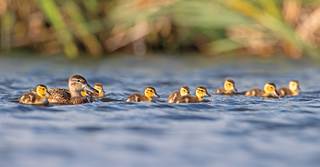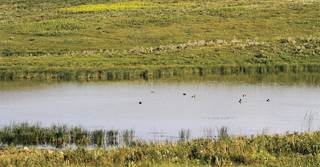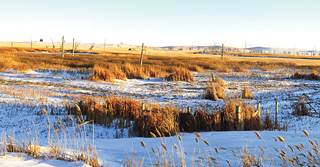Understanding Waterfowl: The Perfect Combination
A variety of factors must come together to create prime wetland conditions on the prairies
A variety of factors must come together to create prime wetland conditions on the prairies
By Scott Stephens, PhD
There is probably no more common question on duck hunters' minds during the off-season than "What are wetland conditions looking like on the prairies?" Because of the strong connection between prairie wetlands and waterfowl populations, that is certainly a relevant question. The answer, however, is more complex than you might expect.
The Prairie Pothole Region of the United States and Canada is defined by a dynamic climate with highly variable precipitation. As a result, the condition of millions of prairie potholes and other wetlands that dot this landscape is closely tied to the wet and dry periods that are typical of this climate. Adding to this variability is a diversity of wetland types, ranging from small, shallow temporary and seasonal ponds that may only hold water for a few weeks after the spring runoff to larger semipermanent and permanent wetlands that only go dry during drought years. Breeding ducks are typically most productive when an abundance of small, shallow wetlands are widely distributed on the landscape and the more permanent wetlands are also at full capacity.
What combination of environmental factors are necessary to create these optimal wetland conditions on the prairies? First, fall water levels set a baseline for wetland conditions heading into winter. If there is substantial "carryover" water in wetlands at freeze-up, less precipitation will be required to fully recharge them the following spring. Conversely, if shallow ponds are dry and many of the semipermanent wetlands have little or no water, significantly more precipitation will be required to improve prospects for breeding ducks.

Photo GARYKRAMER.NET
Perhaps no single factor has a greater influence on waterfowl habitats on the prairies than winter snowfall. Moisture stored in the snowpack typically provides most of the water that fills wetlands in spring. However, soil moisture levels and the timing and duration of the spring melt also affect how much of that water ends up in wetland basins. When fall rains soak the prairie soil prior to freeze-up, a frost seal is formed, which serves as a barrier that prevents melting snow from soaking into the soil. With a good frost seal in place, much of the snow that has accumulated over the winter melts and collects in wetland basins.
The speed of the spring melt also influences how much runoff reaches wetlands. When temperatures rise quickly while the soil is still frozen, snow melts rapidly, filling wetland basins and shallow depressions. In contrast, a more gradual increase in temperatures allows more time for snowmelt to soak into the soil. So even a good winter snowpack doesn't necessarily result in a dramatic improvement in wetland conditions if soil moisture is low at freeze-up or if a slow spring melt occurs. And not all snow is created equal with respect to moisture content either. Wetter snow typically occurs in warmer temperatures, while drier snow falls in colder temperatures.
Thus, the perfect sequence of events for prairie wetlandsand breeding waterfowlbegins with carryover water in wetland basins and high soil moisture at freeze-up followed by a large accumulation of heavy, wet snow and a quick melt. Timely spring and summer rainfall also helps maintain wetland habitats for renesting and brood-rearing waterfowl. Across the Prairie Pothole Region at large, the last time we had that combination of conditions was in 201011, which produced excellent wetland habitat and fueled a dramatic rebound in the populations of many species of ducks.

Photo MICHAELFURTMAN.COM
Waterfowl numbers usually peak following several consecutive years of favorable conditions on the prairies. The good times can't go on forever, however, as wetlands gradually decline in productivity over time. Breeding waterfowl prefer prairie wetlands that are in the "hemi-marsh" stage, typified by a 50:50 ratio of emergent vegetation to open water. Wetlands don't remain in this stage for long. During prolonged periods of wet weather, wetlands can become too deep to support emergent vegetation like cattail and bulrush. This results in fewer nesting sites for diving ducks, like canvasbacks and redheads, which nest in this vegetation. And without the underwater substrate provided by these plants to support invertebrates, food resources for breeding ducks and ducklings also decline.
That's why occasional dry periods are required to maintain the productivity of prairie wetlands. Drought enables wetland soils to consolidate, releasing nutrients stored in dead vegetation and allows plant seeds to sprout on exposed mudflats. When water returns to these basins after a drought, invertebrate populations explode, and breeding pairs and broods find an abundance of food and cover in these newly flooded wetlands.

Photo Rick Bohn
During 2020, poor wetland conditions existed across much of Prairie Canada while pretty good habitat was present in portions of the US prairies such as in eastern South Dakota. When freeze-up occurred last fall, soil moisture levels were low across most of the US and Canadian portions of the Prairie Pothole Region. As a result, many areas lack a frost seal to improve runoff this spring. Moreover, as of this writing in late January, much of the region had received below-average winter snowfall.
Drought is never welcome among duck hunters and other waterfowl enthusiasts, but it is a natural part of the prairie ecosystem. Ducks evolved amid wet and dry cycles on the prairies and are well adapted to deal with highly variable habitat conditions on their breeding grounds. While we can't change the weather, we can help ensure that wetland basins and surrounding grasslands remain intact, setting the stage for the next boom in waterfowl populations when wet weather returns to the pothole country.
Ducks Unlimited uses cookies to enhance your browsing experience, optimize site functionality, analyze traffic, and deliver personalized advertising through third parties. By continuing to use this site, you agree to our use of cookies. View Privacy Policy